House price rises accelerating in Australia
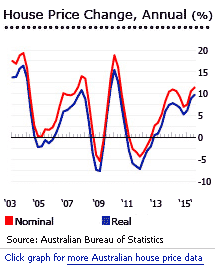 Australia’s housing market continues to rise, amidst modest economic growth. House prices rose by 11.4% in Australia´s eight major cities during the year to end-Q3 2015 (9.72% inflation-adjusted), up from an annual rise of 9.23% in a year earlier and the highest y-o-y increase since Q2 2010, based on figures from the Australian Bureau of Statistics (ABS). House prices increased 2.17% (1.71% inflation-adjusted) quarter-on-quarter in Q3 2015.
Australia’s housing market continues to rise, amidst modest economic growth. House prices rose by 11.4% in Australia´s eight major cities during the year to end-Q3 2015 (9.72% inflation-adjusted), up from an annual rise of 9.23% in a year earlier and the highest y-o-y increase since Q2 2010, based on figures from the Australian Bureau of Statistics (ABS). House prices increased 2.17% (1.71% inflation-adjusted) quarter-on-quarter in Q3 2015.
Sydney saw the biggest increase, with residential property prices surging by 19.9% (18.1% inflation-adjusted) during the year to Q3 2015, followed by Melbourne (9.9%), Canberra (4%), Brisbane (3.8%), Adelaide (3.5%), and Hobart (1.7%). On the other hand, residential property prices dropped in Perth (-3.3%) and Darwin (-2%) over the same period.
The mean price of residential dwellings in Australia was AU$612,200 (US$429,734) in September 2015, up 10.2% from the same period last year, according to the ABS.
New South Wales, especially Sydney, has the most expensive housing in the country, with the mean house price at AU$780,900 (US$548,152) in Q3 2015, about 30% above the national mean house price. In contrast, Tasmania has the cheapest housing in Australia, at a mean price of AU$321,100 (US$225,396) over the same period.
Some critics believe that Australia´s housing market remains severely overvalued.
- The Economist estimated that Australian house prices are overvalued by more than 30% as of Q3 2015.
- According to the Global Real Estate Bubble Index published by investment bank UBS, Sydney house prices are significantly overvalued and at risk of falling in the future. Based on the report, Sydney house prices had increased by about 30% since 2012 while income and rents had stagnated over the same period.
- According to the International Monetary Fund (IMF), housing market risks in Australia remain heightened, especially in Sydney, mainly due to investor credit and interest only loans. House prices are estimated to be moderately overvalued by about 10%.
Yet demand remains strong. In October 2015, seasonally-adjusted purchases of established dwellings rose by 8.4% to 46,868 units from the same period last year, according to ABS. In fact, the value of established dwelling purchases soared by 23.7% to almost AU$18.11 billion (US$12.71 billion) over the same period. Likewise, seasonally-adjusted purchases of new dwellings increased 8.9% y-o-y to 2,953 units while the value of new dwelling purchases soared by 32.4% to almost AU$1.25 billion (US$0.88 billion) over the same period.
The continued strength of the housing market is somewhat surprising, since Australia´s economy is estimated to have grown by a modest 2.4% in 2015, after GDP growth of 2.7% in 2014, 2.1% in 2013, 3.6% in 2012, 2.7% in 2011, 2.3% in 2010 and 1.6% in 2009, according to the IMF. However two factors may partially explain it. The Reserve Bank of Australia (RBA) has kept its cash rate at a record low of 2%, after cutting it by 25 basis points each in February and in May 2015. The other factor is increased purchases of residential real estate by foreign nationals, especially Chinese, who continue to find Australian property very attractive. Proposed foreign investment in the country’s residential real estate market surged to AU$34.7 billion (US$24.36 billion) in 2013-14, up from AU$17 billion (US$11.93 billion) in the previous year, according to the Foreign Investment Review Board (FIRB). China topped the list of real estate approvals, with AU$12.4 billion (US$8.7 billion), twice that of the United States.
Acquisition of residential real estate by foreign nationals and corporations is subject to FIRB approval. Foreigners are not allowed to buy an established (previously occupied) house. They may buy an unoccupied new dwelling, but only if the FIRB feels that the purchase will not add to the shortage of properties available to native Australians.
Australia’s housing boom; crash avoided
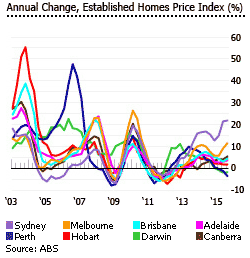
The strength of Australia’s housing market through the recession surprised observers, who had predicted that Australia would suffer one of the worst housing market crashes, because of house price overvaluation.
One reason a crash was avoided was that lending standards have been stricter than in the US. In addition, the government helped first-time homebuyers, introducing a AU$10.4 billion (US$7.24 billion) stimulus package in October 14, 2008 - worth around 1% of GDP - which included the First Home Owner Boost Scheme (FHOB), which raised the First Home Owner Grant (FHOG) from AU$7,000 (US$6,419) to AU$14,000 (US$12,838) for existing dwellings, and to AU$21,000 (AU$19,257) for newly built homes (however, the FHOG reverted back to $7,000 in December 2009 in NSW, and reduced it in other states).
There are also housing shortages due to a rapidly growing population, and in a context of shrinking Australian household sizes. There was also strong immigration from 2004 to 2007.
Housing affordability continues to deteriorate
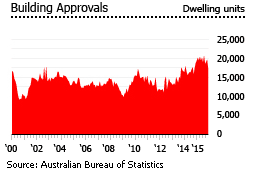
Australia, specially its five major metropolitan areas, remains “severely unaffordable” in 2015. Among the nine developed nations covered by the 12th Annual Demographia International Housing Affordability Survey, Australia was ranked third most unaffordable major housing market in 2015.
The survey uses the Median Multiple to assess housing affordability in 367 metropolitan markets in Australia, Canada, China (Hong Kong), Ireland, Japan, Singapore, New Zealand, the United Kingdom, and the United States. The Median Multiple follows this formula: Median Multiple = median house prices / median household income.
Aside from Sydney, Australia’s least affordable housing markets in 2015 included Melbourne with a Median Multiple of 9.7, followed by Perth (6.6), Adelaide (6.4), and Brisbane (6.1).
Of the 51 Australian markets surveyed in 2015, 33 were rated “severely unaffordable” (Median Multiple of 5.1 and above), 12 were “seriously unaffordable” (Median Multiple between 4.1 and 5.0), 4 was rated moderately affordable (3.1-4.0), and 2 markets evaluated as affordable (3.0 & under).
Among the 367 major markets, Sydney was ranked second most unaffordable. In fact, housing affordability in Sydney deteriorated by about 24% in 2015 from the previous year, the largest change ever recorded in the historu of the Demographia Survey. Outside the major markets, the Tweed Heads (Queensland), is the most severely unaffordable market, with a Median Multiple of 9.3.
This was supported by the UBS Global Real Estate Bubble Index, ranking Sydney as the third most vulnerable market in th world to real estate bubble risk.
The severe housing unaffordability in the country, especially in Sydney, was mainly due to the urban consolidation in Australia during the period, which severely limit or even prohibit new housing construction on or beyond the urban fringe.
Rental yields down, rents rising slightly
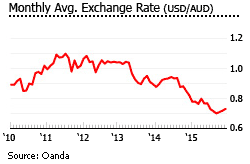
Rental yields in Australia have hit historic lows, amidst strong house price increases. Sydney saw the biggest decline in rental yields, falling to 3.3% in September 2015 from 3.8% in the same period last year, according to CoreLogic RP Data Rentral Report. Likewise, yields in Melbourne dropped to 3% from 3.4% over the same period. On the other hand, Canberra yields remained steady at 4.1% in September 2015 while Darwin had a robust rental yield of 5.9%.
Our own yields research for Australia is now rather old (Global Property Guide Research of August 2014). During the period, the gross rental yield for apartments in Sydney, i.e., the gross return on investment in an apartment if fully rented out, ranged widely, from 2.8% to 5.0%. Small apartments earn significantly higher rental returns than big apartments.
"Gross rental yields at record lows and affordability constraints are acting as a further disincentive, particularly in Sydney where the median unit price is equal to, or higher, than the median house price in every other capital city," said Tim Lawless of CoreLogic RP Data.
During the third quarter of 2015, the average rent in Australia’s major cities rose by a meagre 0.5%, according to CoreLogic. Darwin suffered the largest annual decline in rental rates of 11.4% in Q3 2015, which was followed by Perth (-5.8%). On the other hand, Melbourne and Sydney saw the biggest annual rental growth in Q3 2015, at 2.1% and 1.9% respectively. Minimal annual rent increases were also seen in Hobart (1.5%), Canberrra (1%), Brisbane (0.5%), and Adelaide (0.1%).
“A lot of investors are looking at capital growth potential, rather than rental returns,” said Cameron Kusher of CoreLogic. “That can be successful when properties are climbing, but over the long term, you need some sort of rental return. A lot of properties in Sydney and Melbourne especially don’t currently have that potential.”
Key interest rate on hold
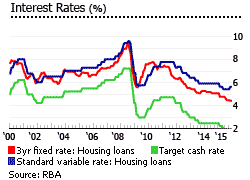
The Reserve Bank of Australia (RBA) kept the official cash rate unchanged at a record low of 2% in December 2015, after cutting it in February and May 2015, in an effort to support borrowing and spending amidst a slowdown in the mining sector.
“Monetary policy needs to be accommodative,” said the RBA. “Low interest rates are acting to support borrowing and spending. While the recent changes to some lending rates for housing will reduce this support slightly, overall conditions are still quite accommodative.”
As a result, interest rates for housing loans were also at their historic lows:
- The average standard variable interest rate for housing loans was 5.65% in December 2015, unchanged from the previous month but down from 5.95% in a year earlier.
- The average discounted variable interest rate for housing loans stood at 4.85% in December 2015, unchanged from the previous month but down from 5.1% in a year ago.
- The three-year fixed interest rate for housing loans stood at 4.45% over the same period, unchanged from the previous month but down from 5.1% in a year ago.
“Growth in lending to investors in the housing market has eased. Supervisory measures are helping to contain risks that may arise from the housing market,” said the central bank.
Mortgage market continues to grow
The Australian mortgage market has grown from around 15% of GDP in the 1970s, to 58% of GDP in 2002 and finally to around 95% last year, thanks to low interest rates.
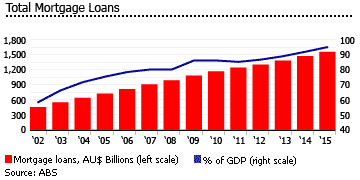
In the third quarter of 2015, the total residential housing loans outstanding in the country rose by around 8% y-o-y to more than AU$1.55 trillion (US$1.09 trillion), based on figures from the Reserve Bank of Australia.
Housing loans for both investors and owner-occupiers increased. During the third quarter of 2015, housing loans for owner-occupiers stood at AU$911.75 billion (US$640 billion), up by 10% from the same period last year. Likewise, housing loans for investors also increased by 4% to AU$526.08 billion (US$369.28 billion) over the same period.
Residential construction declining
Residential construction activity is falling. In October 2015, construction of dwellings in the country also fell both in number and in value, by 12.4% and 7.9%, respectively.
In September 2015, the total number of dwelling starts fell by 3.11% to 52,340 units from a year earlier, according to the Housing Industry Association (HIA). Western Australia registered the biggest drop in housing starts of 20.6% y-o-y in September 2015, followed by Northern Territory (-17.2%), Victoria (-5.5%), Queensland (-4.4%), and South Australia (-2.3%). In contrast, the Australian Capital Territory’s construction sector saw the biggest annual increase in dwelling starts of 15.2% in September 2015, followed by New South Wales (9.8%) and Tasmania (9.8%).
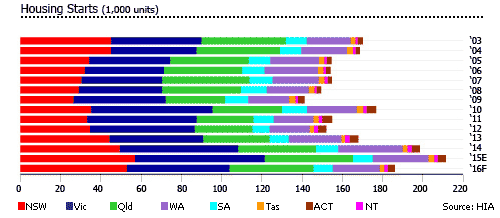
Moreover, housing starts in Australia is expected to fall by 12% to 186,080 units in 2016 from the previous year, according to the HIA.
The decline in housing construction is expected to exacerbate the shortage of affordable housing in the country, which could drive those at the bottom of the market to become renters instead of buying, and struggle with high rents.
Australia’s affordability problem is partly attributed to insufficient construction of new houses. Australia has been under-building new residential dwellings in the past years, for several reasons.
- Stringent urban planning policies and land use restrictions (called ‘smart growth’, ‘urban containment’, etc.). “An increase in state government zoning regulations is a significant factor driving up the cost of housing”, said Reserve Bank of Australia Governor Glenn Stevens.
- Tax burdens on builders and developers. In New South Wales, government taxes and other charges are estimated to account for about 30% of the price of new houses.
- Due to the extended impact of the global credit crunch, some developers continue to struggle to secure finance.
The value of dwelling stock owned by households in the country rose by 12.2% y-o-y to AU$5.56 trillion (US$3.94 trillion) in September 2015, according to the ABS. New South Wales accounted for the biggest share of the total dwelling stock at about 40%, followed by Victoria (26.5%), Queensland (15.4%), and Western Australia (9.9%).
Over the same period, the number of residential dwellings in Australia stood at around 9.57 million, up by 1.7% from a year earlier.
Economic growth remains modest, exports improving
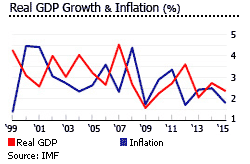
In the third quarter of 2015, Australia’s economic growth accelerated to 2.5% from a year earlier, up from annual growth rates of 1.9% in Q2 2015, 2.1% in Q1 2015, and 2.2% in Q4 2014, fuelled by the biggest increase in exports since 2000 and supported by the central bank’s decision to keep its key rates steady, based on figures from the Reserve Bank of Australia (RBA).
Economic growth was estimated at around 2.4% last year, from an average annual growth of 3% from 2000 to 2014, according to the International Monetary Fund (IMF).
The RBA kept the target cash rate at 2% in December 2015, after a cutting it by 25 basis points in May 2015, in an effort to buoy the domestic economy amidst an economic slowdown in China, Australia’s largest trading partner.
The Australian dollar (AUD) depreciated by about 11% from AUD1 = USD0.8202 in December 2014 to AUD1 = USD0.7306 in December 2015.
Australia’s export industry is now improving. In Q3 2015, the country’s current account deficit narrowed to about AU$18,104 million (US$12,826 million), down from a deficit of AU$20,506 million (US$14,528 million) in the previous quarter, according to the ABS. Despite this, demand from China remains unstable.
In December 2015, the nationwide unemployment rate dropped to 5.8%, unchanged from the previous month and down from 6.1% in the same period last year, according to the ABS. There were about 727,500 unemployed persons in Australia in December 2015, down by 3.6% from a year earlier.
Consumer prices rose by 1.7% in Q4 2015 from a year earlier, slightly up from 1.5% in the previous quarter, but unchanged from a year ago, amidst falling petrol prices. Australia’s nationwide inflation rate averaged 3.1% during 2008-2011 before declining to 2.2% during 2012-2014.